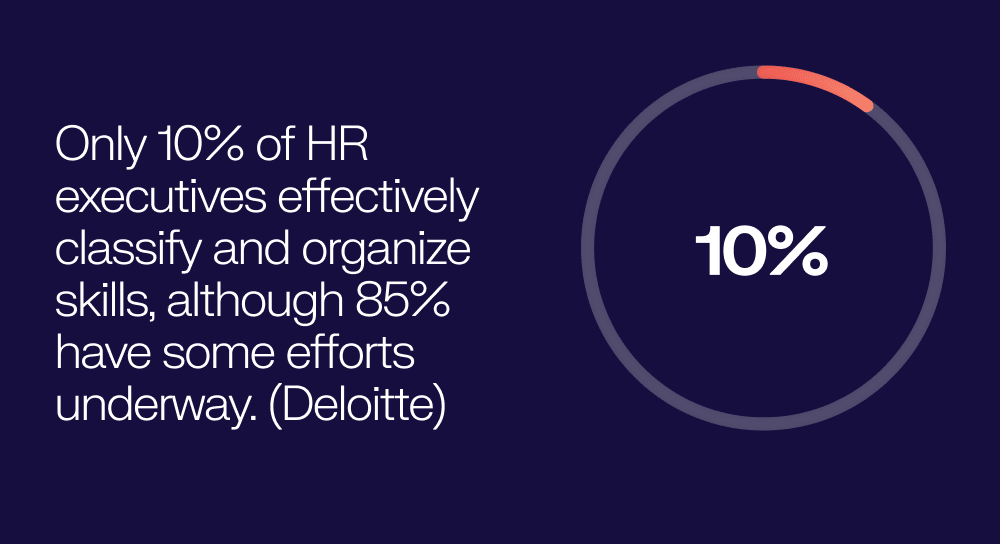What Is A Skills Taxonomy, And How Do I Create One?
The ability to understand and categorize skills effectively is crucial for talent management, resource allocation, better workforce plans, and organizational success. Achieving this, and setting the groundwork for skills-based transformation, relies on a skills taxonomy.
But what exactly is a skills taxonomy, and how can you create one for your organization?
Defining a Skills Taxonomy 🗂️
A skills taxonomy is essentially a system to classify and organize skills within an organization. Think of it as a hierarchical structure that breaks down the various skills required across different roles and functions into manageable categories and subcategories.
Why Create a Skills Taxonomy? 🤔
Every business needs to work out what skills they require in order to do the tasks that will make them successful (understand skills demand). While individual leaders or managers may have a grasp of this for their team or department, an organization-wide taxonomy gives the business more precision and agility when it comes to hiring, developing, managing and retaining sought-after skills.
- Clarity and alignment: It provides clarity on the specific skills needed for different roles, ensuring alignment between organizational objectives and individual capabilities. When people do their own thing, you end up with, for example, 15 definitions for “project management” across the business.
- Talent Management: A skills taxonomy helps HR professionals and managers to better assess, track, and develop employee skills, enhancing talent management practices.
- Resource allocation: By identifying skill gaps, organizations can allocate resources more effectively, focusing on areas critical to achieving strategic goals – redeploying or upskilling employees from other areas of the business, for example.
- Learning & Development: With a clear understanding of the skills landscape, organizations can design targeted learning and development programs tailored to the needs of employees at different proficiency levels.

Creating Your Skills Taxonomy 📑
It’s not easy to build a skills taxonomy. It takes a lot of time, effort and resources – and will be out of date almost as soon as you launch it.
The ideal approach to ‘creating’ a skills taxonomy is to use a pre-existing one – there are companies who specialize in this, and can deliver the strong data foundation and framework you need.
The key steps are:
- Think about outcomes: What do you want your skills taxonomy to do? What other systems or processes will it be powering? How granular and numerous do you want to get with the skills included?
- Identify core skills: Start by identifying the core skills and competencies required for success within your organization. These may include technical skills, soft skills, industry-specific knowledge, and certifications.
- Organize into categories: Group the identified skills into broad categories or domains, such as Leadership, Communication, Technical Proficiency, Project Management, etc.
- Create a hierarchical structure: Break down each category into subcategories and further into specific skills or competencies. For example, under Technical Proficiency, you might have subcategories like Programming Languages, Database Management, Networking, etc.
- Define proficiency levels: Specify proficiency levels for each skill or competency, ranging from Basic to Expert. This helps in assessing skill levels accurately and tailoring development plans accordingly.
- Seek input and feedback: Collaborate with subject matter experts, department heads, and employees to ensure comprehensive coverage and accuracy of the skills taxonomy. Their insights can also help identify emerging skills and future skill requirements.
- Regular review: Skills requirements evolve over time, so it’s essential to regularly review and update the skills taxonomy to reflect current needs and priorities. This requires technology to do effectively: you need a tool that will take inputs from other systems to keep your skills taxonomy up to date.

How Beamery Helps 🚀
At Beamery, we have hundreds of thousands of free text skills that are mapped to a mutually exclusive and collectively exhaustive set of over 35,000 “normalized” skills (with descriptions), alternative labels and translations into many languages.
There are skills categories and links to roles, and it’s dynamic and frequently updated as new skills come into the market.
If you think you need to wait years for a skills taxonomy, think again. With Beamery, you can unify skills data from different sources, ontologies, and HCM systems into a single, universal taxonomy for a consistent and real-time view of what you have today, and what you’ll need to plan for in the future... in a matter of days or weeks.